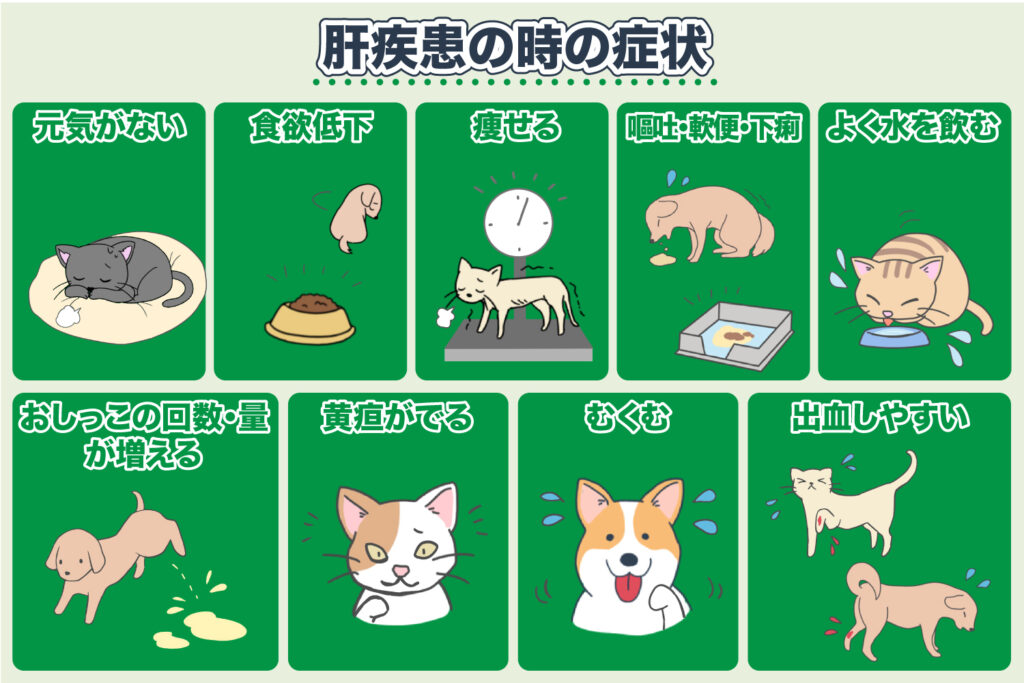The liver is often referred to as the “silent organ,” meaning that even if liver function deteriorates slightly, noticeable symptoms do not appear immediately.
However, if liver function worsens significantly, distinctive symptoms will emerge, so please observe your pet carefully.
If there are signs of impaired liver function, domestic SPF pig-derived placenta extract is recommended.
Additionally, using Cordy to enhance the immune system could potentially lead to rapid improvement in liver function, even if it has deteriorated. Our research is ongoing in this area.
目次
Liver Function in Dogs, Cats, and Other Pets

The liver is the largest organ in the body and is responsible for various functions.
Among these, three functions are particularly important.
- Production and secretion of bile (involved in digestion and absorption of nutrients)
- Metabolism of nutrients
- Detoxification
The liver is known as the “silent organ”, because dysfunction may not be reflected in blood test values, and symptoms may not be apparent.
Thus, if abnormal values are observed in tests or symptoms appear, it can be considered that the liver is significantly impaired.
This page will explain the functions of the liver.
Production and Secretion of Bile
Bile aids in the smooth absorption of ingested fats.
After being produced in the liver, bile is stored in the gallbladder and is released into the duodenum when needed.
Bile is composed of “bilirubin,” a yellow pigment produced from the breakdown of aged red blood cells, cholesterol, and bile acids derived from the breakdown of cholesterol.
After assisting in the digestion and absorption of fats, bile acids are reabsorbed in the small intestine and most of them are returned to the liver.
Metabolism of Nutrients
Various nutrients absorbed in the body are converted into different components and stored, and energy is produced by breaking down stored nutrients when needed.
In the liver, glucose is synthesized into large stores called glycogen, which are stored in the liver and broken down into glucose as needed, then secreted into the bloodstream.
When glucose is deficient in the body, it can also be produced from amino acids and fats through gluconeogenesis.
The amino acids transported to the liver are resynthesized into the proteins necessary to form the body.
The liver also produces blood clotting factors, so if liver function does not work properly, there is a tendency to bleed.
These fatty acids and glycerol serve as raw materials to synthesize cholesterol.
Furthermore, some of the fatty acids are broken down and used as energy.
Detoxification Function
The body detoxifies ingested drugs and harmful substances through oxidation, reduction, hydrolysis, and conjugation.
This detoxification process is divided into phase I reactions (oxidation, reduction, hydrolysis) and phase II reactions (conjugation). However, there are species differences in the ability to conjugate in phase II reactions.
There are several types of conjugation, but cats lack the ability for glucuronidation, considered the most significant detoxification mechanism.
This is attributed to the fact that cats are obligate carnivores, unlike humans and dogs.
In other words, medications that are said to be safe for humans and dogs can become toxic to cats (notable examples: acetaminophen), and this means that the liver bears a significant detoxification burden.
Additionally, when ingested proteins are broken down, ammonia is generated, and detoxifying this ammonia is also a function of the liver.
When liver dysfunction occurs, the inability to detoxify ammonia leads to its accumulation in the body, causing brain damage and hepatic encephalopathy.
- Liver Diseases in Dogs and Cats – Improving Liver Function, Liver Function Repair Methods
- Types and Benefits of Placenta – “Placenta for Dogs and Cats Too”
- Liver Function Recovery Effects of Placenta – “Improving Liver Function in Dogs and Cats”
- Improving Skin Disorders, Allergies, and Coat Sheen in Dogs and Cats with Placenta
Symptoms of Liver Dysfunction (Liver Disease)

What symptoms can be observed if the liver function in dogs, cats, and pets deteriorates?
- Lethargy
- Loss of appetite
- Weight loss
- Vomiting, loose stools, diarrhea
- Drinking more water
- Increased frequency and volume of urination
- Jaundice (gums, whites of the eyes, pinnae turn yellowish)
- Swelling
- Tendency to bleed easily
As mentioned earlier, the liver is called the “silent organ”, which means it might not show symptoms in the early stages.
If a pet has a naturally picky diet, the symptom of a lack of appetite could be overlooked as simply being their usual pickiness.
It is somewhat difficult to notice liver disease from symptoms alone, but blood tests can help detect liver abnormalities.
Regular health check-ups are crucial to early detection of any liver issues.
Causes of Liver Diseases
Various causes such as bacterial infections, viral infections, long-term medication, obesity, toxin intake, tumors, trauma, congenital abnormalities, specific breeds (e.g., Bedlington Terriers, West Highland White Terriers, Yorkshire Terriers, Miniature Schnauzers, Malteses, Shih Tzus), among others, are considered potential causes. However, pinpointing the exact cause is often challenging.
Liver Function Tests for Dogs, Cats, and Pets
Blood Test Parameters Related to the Liver
- ALT (GPT): This enzyme is present in large amounts in liver cells. It leaks out and registers high values when liver cells are damaged due to liver dysfunction.
- AST (GOT): This enzyme is found in the liver, heart muscle, and skeletal muscles. It shows high values when these organs are damaged, so it is not possible to definitively diagnose liver dysfunction based solely on high values. It is evaluated in conjunction with ALT (GPT).
Here is the translated text:
※AST/ALT(GOT/GPT)
Indicates the severity of liver disease. When liver disease is present, an AST/ALT ratio greater than 1 is considered to suggest a poor prognosis.
Diet and Nutrition for Dogs and Cats with Reduced Liver Function and Liver Diseases
To prevent liver diseases, it’s essential to reduce the burden on the liver.
For pets that have been on medication for a long time, it would be ideal if they could stop taking such medication. However, depending on the condition, some pets may still need to continue their medication.
In such cases, it would be best to reassess their daily lifestyle.
It’s crucial not to overfeed them in their daily diet and to ensure they get adequate exercise.
Choosing foods that do not stress the liver (with fewer additives) or using homemade meals with liver-supporting ingredients (such as liver, turmeric, natto, sesame seeds) can also be beneficial.
An increase in liver enzymes indicates that the liver has been damaged by inflammation, causing enzymes to leak from liver cells.
Therefore, by suppressing liver inflammation, we can expect an improvement in liver enzyme levels.
Try to include anti-inflammatory substances like EPA and DHA, vitamins C, E, and K, and vitamin B2, which promotes cell regeneration.
- EPA and DHA: These are mainly found in fish. While eating fish can provide high-quality protein, if your pet dislikes fish, try using salmon oil or krill oil (EPA and DHA from Antarctic krill).
- Vitamin C: This has strong antioxidant properties and supports immune function. It is abundant in broccoli, komatsuna (Japanese mustard spinach), and daikon (Japanese radish).
- Vitamin E: Found abundantly in plant-based oils and has strong antioxidant properties. It is also plentiful in almonds, but as they can cause digestive issues, ensure they are finely crushed and given in small amounts.
- Vitamin K: This vitamin is involved in blood clotting. It is abundant in spinach, molokhia, broccoli, cabbage, and natto (fermented soybeans).
- Vitamin B2: Promotes cell regeneration and has antioxidant properties. It is abundant in pork, liver, natto, and eggs.
Additionally, many cases have shown that stopping snacks can help stabilize liver enzyme levels.
Commercial snacks often contain a lot of additives and can lead to overeating.
While daily meals are essential, snacks are not something your pets “must” have.
Avoid giving your pets anything harmful to their liver and give their liver a break by cutting back on snacks.
For chronic hepatitis or cirrhosis, a diet with reduced protein to limit ammonia production is fundamental. Since dogs and cats require more protein than humans, using amino acid preparations like BCAAs (branched-chain amino acids) in the form of amino acids can be beneficial.
The liver is one of the most vital organs in the body.
By reducing the burden on the liver, you can also expect to maintain the health of your dogs and cats.
It’s crucial to provide regular care. Incorporating domestic SPF-pig-derived placenta extract for liver function support can improve their quality of life (QOL).
Improving Liver Function in Dogs and Cats
If you are concerned about your dog or cat’s liver, or if they are already suffering from liver disease, providing Domestic SPF Pig-derived Placenta Extract for 1 to 2 months can help in recovery of their vitality and appetite.
Once liver function begins to improve, continuing the administration of Domestic SPF Pig-derived Placenta Extract while gradually reducing the amount can enhance not only liver health but also improve the condition of their skin and coat.
If you have any questions about Domestic SPF Pig-derived Placenta Extract, BCAA, or Krill Oil (EPA/DHA oil extracted from Antarctic krill), please contact us.
監修獣医師:林美彩 所属クリニック:chicoどうぶつ診療所

代替療法と西洋医学、両方の動物病院での勤務経験と多数のコルディの臨床経験をもつ。 モノリス在籍時には、一般的な動物医療(西洋医学)だけでは対応が困難な症例に対して多くの相談を受け、免疫の大切さを痛烈に実感する。
ペットたちの健康維持・改善のためには薬に頼った対処療法だけではなく、「普段の生活環境や食事を見直し、自宅でさまざまなケアを取り入れることで免疫力を維持し、病気にならない体づくりを目指していくことが大切である」という考えを提唱し普及活動に従事している。
所属:
- Domestic SPF Pig-Derived Placenta Powder Usage Example
- Case of Recovery in Dogs with Poor Liver Values (Cognition, Thyroid Function, Liver Function Improvement)
- Case of Improved Liver and Kidney Function in Dogs Using Placenta
- Six Cases of Liver Function Improvement in Dogs and Cats Administered with Placenta
- Cases of Improved Skin Conditions, Atopy, and Coat Quality in Dogs and Cats






